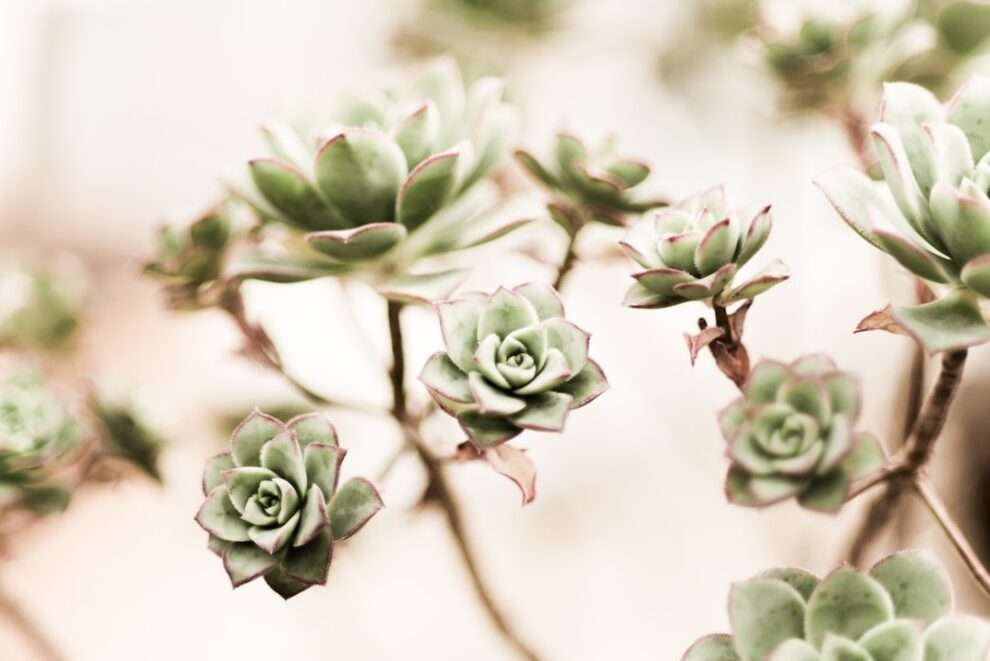Burro’s Tail, also known as Sedum morganianum, is a popular choice among succulent enthusiasts due to its unique cascading growth habit and beautiful trailing stems. This succulent is native to Mexico and is a member of the Crassulaceae family. Its distinctive appearance and low-maintenance nature make it a favorite among both beginner and experienced succulent growers.
One of the reasons why Burro’s Tail is so beloved is its ability to thrive in a variety of conditions. It can be grown both indoors and outdoors, making it a versatile choice for any succulent lover. Its trailing stems can grow up to three feet long, creating a stunning display when planted in hanging baskets or placed on shelves or windowsills.
The History and Origin of Burro’s Tail Succulent
Burro’s Tail succulent is native to the states of Hidalgo and Puebla in Mexico. It was first discovered in the late 19th century by a botanist named Nathaniel Britton. The plant was named after its resemblance to the tail of a donkey, hence the name “Burro’s Tail.”
The plant’s natural habitat is rocky slopes and cliffs, where it grows in crevices and cracks. It has adapted to survive in arid conditions by storing water in its fleshy leaves and stems. This ability to store water makes it an excellent choice for those who tend to forget to water their plants regularly.
Physical Characteristics of the Burro’s Tail Succulent
Burro’s Tail succulent has long, trailing stems that are covered in plump, fleshy leaves. The leaves are blue-green in color and have a powdery coating called farina, which helps protect them from excessive sunlight. The stems can grow up to three feet long and are covered in small, overlapping leaves that give the plant its cascading appearance.
The leaves of Burro’s Tail are cylindrical in shape and can grow up to two inches long. They are tightly packed together along the stems, creating a dense and lush look. When the plant is well cared for, it can produce small, star-shaped flowers in shades of pink or red during the summer months.
The Best Growing Conditions for Burro’s Tail Succulent
Burro’s Tail succulent thrives in bright, indirect light. It prefers temperatures between 65-75°F (18-24°C) but can tolerate higher temperatures as long as it is not exposed to direct sunlight for extended periods. In fact, too much direct sunlight can cause the leaves to burn or turn yellow.
When it comes to soil, Burro’s Tail prefers well-draining soil that is slightly acidic. A mix of cactus potting soil and perlite or pumice works well for this succulent. It is important to avoid overwatering, as this can lead to root rot. Allow the soil to dry out completely between waterings and then water thoroughly, ensuring that excess water drains out of the pot.
Fertilizing Burro’s Tail succulent is not necessary but can help promote healthy growth. Use a balanced liquid fertilizer diluted to half strength once a month during the growing season (spring and summer). Avoid fertilizing during the winter months when the plant is dormant.
Propagation Techniques for Burro’s Tail Succulent
Burro’s Tail succulent can be propagated from stem cuttings. To propagate, simply take a healthy stem cutting that is at least four inches long and remove the lower leaves. Allow the cutting to dry out for a few days until a callus forms on the cut end.
Once the cutting has calloused, place it in a well-draining potting mix and water lightly. It is important to avoid overwatering at this stage, as the cutting is susceptible to rot. Place the pot in a bright, indirect light location and mist the cutting occasionally to provide some humidity.
After a few weeks, the cutting should start to develop roots. Once the roots are established, you can treat the new plant as you would a mature Burro’s Tail succulent.
Common Pests and Diseases that Affect Burro’s Tail Succulent

Like all plants, Burro’s Tail succulent is susceptible to pests and diseases. The most common pests that can infest this succulent include mealybugs, aphids, and spider mites. These pests can be controlled by regularly inspecting the plant for signs of infestation and treating with an appropriate insecticide or by using natural methods such as neem oil or insecticidal soap.
Diseases that can affect Burro’s Tail succulent include root rot and fungal infections. These diseases are often caused by overwatering or poor drainage. To prevent these issues, ensure that the plant is potted in well-draining soil and watered sparingly. If you notice any signs of disease, such as wilting or discoloration, remove the affected parts of the plant and adjust your watering routine.
Creative Ways to Display Burro’s Tail Succulent in Your Home
Burro’s Tail succulent’s cascading growth habit makes it a perfect choice for hanging baskets or trailing planters. Its long stems can also be trained to grow along shelves or windowsills, creating a stunning display of trailing foliage.
Another creative way to display Burro’s Tail succulent is by planting it in a vertical garden or living wall. Its trailing stems will drape down the wall, adding a touch of greenery and texture to any space.
If you prefer a more minimalist look, you can plant Burro’s Tail in a small, shallow dish or terrarium. Its trailing stems will spill over the edges, creating a beautiful and compact arrangement.
How to Care for Your Burro’s Tail Succulent During Different Seasons
During the growing season (spring and summer), Burro’s Tail succulent requires more frequent watering. Water thoroughly when the soil is dry to the touch and allow excess water to drain out of the pot. In hot weather, you may need to water more often to prevent the plant from drying out.
In the winter months, Burro’s Tail goes into a period of dormancy and requires less water. Reduce watering frequency and allow the soil to dry out completely between waterings. It is also important to protect the plant from cold drafts or temperatures below 50°F (10°C), as this can cause damage.
Frequently Asked Questions About Burro’s Tail Succulent
1. How often should I water my Burro’s Tail succulent?
Burro’s Tail succulent should be watered when the soil is dry to the touch. During the growing season, this may be once every 7-10 days, while in winter, it may be once every 2-3 weeks.
2. Can I grow Burro’s Tail succulent outdoors?
Yes, Burro’s Tail succulent can be grown outdoors in areas with mild climates. It prefers bright, indirect light and well-draining soil.
3. Why are the leaves of my Burro’s Tail turning yellow?
Yellow leaves on a Burro’s Tail succulent can be a sign of overwatering or too much direct sunlight. Adjust your watering routine and provide some shade if necessary.
4. How long does it take for a stem cutting to root?
A stem cutting of Burro’s Tail succulent can take anywhere from 2-6 weeks to develop roots. Be patient and provide the cutting with the right conditions for successful rooting.
Why Burro’s Tail Succulent is a Must-Have for Any Succulent Lover
In conclusion, Burro’s Tail succulent is a must-have for any succulent lover due to its unique cascading growth habit and beautiful trailing stems. Its low-maintenance nature and ability to thrive in a variety of conditions make it a popular choice among both beginner and experienced succulent growers.
Whether you choose to display it in a hanging basket, on a shelf, or in a terrarium, Burro’s Tail succulent is sure to add a touch of beauty and elegance to any space. With proper care and attention, this stunning succulent will reward you with its lush foliage and cascading stems for years to come. So why not add a Burro’s Tail succulent to your collection today?
If you’re a succulent enthusiast looking to expand your collection, you won’t want to miss out on the article “Unleashing the Beauty of Donkey Tail Succulent: A Guide to Growing and Caring for This Unique Plant” on GirlsGist. This comprehensive guide provides all the information you need to successfully grow and care for the stunning Burro’s Tail succulent. From watering tips to sunlight requirements, this article covers it all. So, grab your gardening gloves and head over to GirlsGist to learn more about this cascading succulent delight. (source)
FAQs
What is a Burro’s Tail succulent?
Burro’s Tail, also known as Sedum morganianum, is a trailing succulent plant that is native to Mexico and Honduras. It is characterized by its long, trailing stems covered in small, plump leaves that resemble the tail of a donkey.
How do you care for a Burro’s Tail succulent?
Burro’s Tail succulents prefer bright, indirect light and well-draining soil. They should be watered sparingly, allowing the soil to dry out completely between waterings. They are also sensitive to cold temperatures and should be kept in a warm environment.
Can Burro’s Tail succulents be propagated?
Yes, Burro’s Tail succulents can be propagated through stem cuttings. Simply cut a stem from the plant and allow it to callus over for a few days before planting it in well-draining soil.
What are some common pests and diseases that affect Burro’s Tail succulents?
Burro’s Tail succulents are susceptible to mealybugs, spider mites, and scale insects. They can also be affected by root rot if overwatered or kept in soil that does not drain well.
Can Burro’s Tail succulents be grown indoors?
Yes, Burro’s Tail succulents can be grown indoors as long as they receive bright, indirect light and are kept in well-draining soil. They can also be grown in hanging baskets to showcase their trailing stems.

















Add Comment